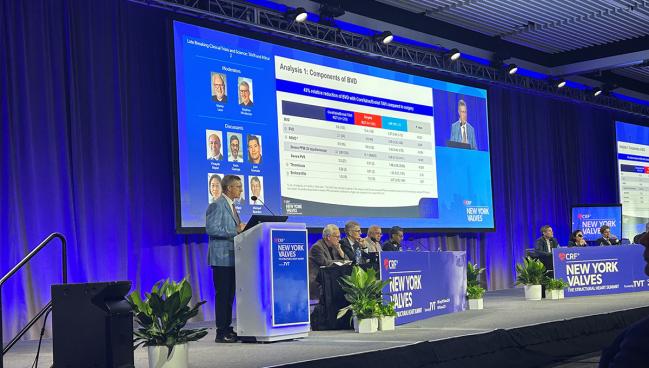Bioprosthetic Valve Dysfunction Tied to Worse Outcomes After AVR
Deterioration was less likely after TAVI with self-expanding valves than after surgery, but outcomes suffered in both groups.

NEW YORK, NY—Development of bioprosthetic valve dysfunction (BVD) may contribute to worse outcomes at 5 years after transcatheter or surgical valve replacement in patients with symptomatic severe aortic stenosis and an intermediate or greater surgical risk, according to an analysis of studies involving self-expanding TAVI valves.
BVD, which was less frequently observed after TAVI with the CoreValve or Evolut R (both Medtronic) than after surgery, was associated with significantly greater risks of all-cause and cardiovascular mortality, hospitalization for valve disease or worsening heart failure, and a composite of those outcomes. Steven Yakubov, MD (Riverside Methodist Hospital, OhioHealth, Columbus), reported the new findings last week at New York Valves 2024, previously known as the TVT meeting.
“As clinicians, it’s up to us to keep monitoring these valves, assess their hemodynamic performance, [and] detect BVD when possible,” he said, adding that the association between BVD and poorer clinical outcomes “should be a consideration as we choose our TAVI devices for patients, especially those who have a longer life expectancy.”
Validating BVD Definitions
Although there is some evidence linking structural valve deterioration (SVD) after aortic valve replacement with adverse clinical outcomes, data are limited on the relationship between more comprehensive criteria for BVD—which encompass SVD and other variables—and clinical outcomes, Yakubov said.
In this study, he and his colleagues defined BVD using the following criteria:
- SVD: mean gradient increase ≥ 10 mm Hg from 30 days/discharge to last follow-up echo plus ≥ 20 mm Hg at last echo or new onset, or an increase to at least moderate intraprosthetic aortic regurgitation
- Nonstructural valve deterioration: severe prosthesis-patient mismatch at 30 days/discharge or severe paravalvular regurgitation through 5 years
- Clinical valve thrombosis
- Infective endocarditis
The investigators aimed to validate these criteria using multiple studies of the CoreValve and Evolut R self-expanding TAVI valves. The first part of the analysis assessing the incidence of BVD included 2,401 patients with intermediate or higher surgical risk who were randomized to TAVI versus surgery in the CoreValve US Pivotal Trial and SURTAVI. For the second part of the analysis examining the link between BVD and outcomes, the researchers added patients from the CoreValve US Pivotal Extreme Risk trial and an intermediate-risk continued access study, bringing the total number of TAVI-treated participants to 3,351.
Through roughly 5 years of follow-up, BVD was significantly less likely after TAVI than after surgery (9.6% vs 15.4%; subdistribution HR 0.57; 95% CI 0.44-0.73). That difference was driven by lower rates of both SVD (2.1% vs 4.5%; subdistribution HR 0.50; 95% CI 0.30-0.82) and nonstructural valve deterioration (5.5% vs 9.6%; subdistribution HR 0.55; 95% CI 0.40-0.75).
TAVI was associated with a lower rate of severe prosthesis-patient mismatch (3.7% vs 12.1%) but a higher rate of severe paravalvular regurgitation (2.3% vs 0.3%; P < 0.001 for both). There were low rates of valve thrombosis and endocarditis, with no differences between groups.
The lower BVD risk with TAVI was consistent in patients with either small or large annuli, using a cutoff of 23 mm for annular diameter.
When pooling all the TAVI and surgical patients together, BVD was associated with greater risks of:
- All-cause mortality (HR 1.58; 95% CI 1.41-1.77)
- Cardiovascular mortality (HR 1.85; 95% CI 1.61-2.13)
- Hospitalization for valve disease/worsening heart failure (HR 1.50; 95% CI 1.26-1.79)
- Composite of those outcomes (HR 1.59; 95% CI 1.42-1.78)
The results were similar when the TAVI and surgery groups were analyzed separately.
After further adjustment for baseline covariates and surgical risk, BVD remained significantly associated with greater risks of both all-cause death (HR 1.53; 95% CI 1.35-1.72) and cardiovascular death (HR 1.76; 95% CI 1.52-2.04) at 5 years.
A Call for Greater Standardization
Rebecca Hahn, MD (NewYork-Presbyterian/Columbia University Irving Medical Center, New York, NY), led the discussion following Yakubov’s presentation, saying, “While I agree that the endpoints like structural valve deterioration and early evidence of bioprosthetic valve performance require clinical validation to inform the field, we’re now learning that a lot of these endpoints happen to be device-specific.” She added that the metrics are also influenced by how they’re measured and by other unexpected confounders.
“What the field needs really is standardization of the definitions, as well as long-term follow-up for these devices, because that is what’s going to allow us to perhaps determine device-specific predictive models and performance metrics,” Hahn said.
She said that VARC-3 was the latest attempt to reach such consensus, and pointed out that the BVD definitions used in the current study—which included a mix of moderate and severe criteria—were not consistent with the VARC-3 metrics or those used in other studies, such as the SMART trial. She noted, too, that a prior study showed no significant difference in SVD between the TAVI and surgery groups when the VARC-3 criteria were used.
Surgeon Michael Reardon, MD (Houston Methodist DeBakey Heart & Vascular Center, TX), one of the panelists during the late-breaking clinical trial session and senior author of that previous study, noted that the curves for SVD separated in favor of TAVI, as in the current study, and that the difference did not meet statistical significance due to the loss of about 20% of the data because of missing information on Doppler velocity index and effective orifice area.
Todd Neale is the Associate News Editor for TCTMD and a Senior Medical Journalist. He got his start in journalism at …
Read Full BioSources
Yakubov SJ. Impact of bioprosthetic valve performance on 5-year clinical outcomes after self-expanding TAVI or surgery in patients at intermediate or greater surgical risk. Presented at: New York Valves 2024. June 7, 2024. New York, NY.
Disclosures
- Yakubov reports research support and honoraria from Boston Scientific and Medtronic.





Comments